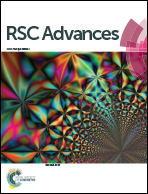A novel bio-electro-Fenton system with dual application for the catalytic degradation of tetracycline antibiotic in wastewater and bioelectricity generation
Abstract
In this new insight, the potential application of the eco-friendly Bio-Electro-Fenton (BEF) system was surveyed with the aim of simultaneous degradation of tetracycline and in situ generation of renewable bioenergy without the need for an external electricity source. To shed light on this issue, catalytic degradation of tetracycline was directly accrued via in situ generated hydroxyl free radicals from Fenton's reaction in the cathode chamber. Simultaneously, the in situ electricity generation as renewable bioenergy was carried out through microbial activities. The effects of operating parameters, such as electrical circuit conditions (in the absence and presence of external resistor load), substrate concentration (1000, 2000, 5000, and 10 000 mg L−1), catholyte pH (3, 5, and 7), and FeSO4 concentration (2, 5, and 10 mg L−1) were investigated in detail. The obtained results indicated that the tetracycline degradation was up to 99.04 ± 0.91% after 24 h under the optimal conditions (short-circuit, pH 3, FeSO4 concentration of 5 mg L−1, and substrate concentration of 2000 mg L−1). Also, the maximum removal efficiency of anodic COD (85.71 ± 1.81%) was achieved by increasing the substrate concentration up to 2000 mg L−1. However, the removal efficiencies decreased to 78.29 ± 2.68% with increasing substrate concentration up to 10 000 mg L−1. Meanwhile, the obtained maximum voltage, current density, and power density were 322 mV, 1195 mA m−2, and 141.60 mW m−2, respectively, at the substrate concentration of 10 000 mg L−1. Present results suggested that the BEF system could be employed as an energy-saving and promising technology for antibiotic-containing wastewater treatment and simultaneous sustainable bioelectricity generation.



 Please wait while we load your content...
Please wait while we load your content...